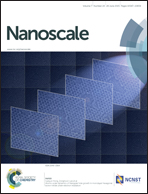Novel ferrocene-anchored ZnO nanoparticle/carbon nanotube assembly for glucose oxidase wiring: application to a glucose/air fuel cell
Abstract
Glucose oxidase (GOx) is immobilized on ZnO nanoparticle-modified electrodes. The immobilized glucose oxidase shows efficient mediated electron transfer with ZnO nanoparticles to which the ferrocenyl moiety is π-stacked into a supramolecular architecture. The constructed ZnO-Fc/CNT modified electrode exhibits high ferrocene surface coverage, preventing any leakage of the π-stacked ferrocene from the newly described ZnO hybrid nanoparticles. The use of the new architecture of ZnO supported electron mediators to shuttle electrons from the redox centre of the enzyme to the surface of the working electrode can effectively bring about successful glucose oxidation. These modified electrodes evaluated as a highly efficient architecture provide a catalytic current for glucose oxidation and are integrated in a specially designed glucose/air fuel cell prototype using a conventional platinum–carbon (Pt/C) cathode at physiological pH (7.0). The obtained architecture leads to a peak power density of 53 μW cm−2 at 300 mV for the Nafion® based biofuel cell under “air breathing” conditions at room temperature.


 Please wait while we load your content...
Please wait while we load your content...